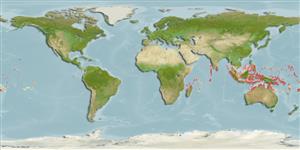>
Atheriniformes (Silversides) >
Atherinidae (Silversides) > Atherinomorinae
Etymology: Hypoatherina: Greek, hypo = under + Greek, atherina, the Greek name for the eperlane; 1770 (Ref. 45335).
Eponymy: Dr Clifford Adrian Barnes (1905-1995) was an American marine scientist who was Professor of Oceanography at the University of Washington, Seattle (1947–1973) his alma mater and Professor Emeritus after retirement. [...] (Ref. 128868), visit book page.
More on author: Schultz.
Environment: milieu / climate zone / depth range / distribution range
بوم شناسي
دريايي وابسته به آب سنگ; تغييرات عمق 0 - 5 m (Ref. 86942). Tropical; 12°N - 20°S
Indo-Pacific: East Africa to the northern Cook Islands, north to New Guinea and the Marshall Islands, south to northern Australia, New Caledonia and Fiji.
Size / Weight / سن
Maturity: Lm ? range ? - ? cm
Max length : 10.0 cm TL جنس نر / بدون خواص جنسي; (Ref. 48635); common length : 4.0 cm TL جنس نر / بدون خواص جنسي; (Ref. 2871)
خارهاي باله پشتي (کل) : 6 - 8; شعاع نرم باله پشتي (کل) : 8 - 12; خارهاي باله مخرجي: 1; شعاع نرم باله مخرجي: 12 - 17. Ascending process of premaxilla long and slender; ramus of dentary highly elevated posteriorly; midlateral band wide, broadest between anus and anal fin (Ref. 9760). First dorsal fin above middle of body; second dorsal fin originates behind the beginning of the anal fin; mid-lateral scales 40-43; transverse scales 5; predorsal scales 16-19 (Ref. 2334). Midlateral band width 2.3-3.3 in body depth (Ref. 37816).
Inhabits lagoons and along shorelines of outlying islands (Ref. 3302). During daylight, schooling fish may be periodically seen to jump out of the water to avoid predators. They are also easily attracted to light. The fish are gravid at about 4-4.5 cm SL by July in the northern hemisphere. Because of their large numbers, they are probably important as forage food for larger fishes (Ref. 9760).
Life cycle and mating behavior
بلوغ | تولید مثل | تخم ریزی | تخم ها | Fecundity | توزاد ( لارو)
Oviparous, distinct pairing during breeding (Ref. 205).
Ivantsoff, W., 1984. Atherinidae. In W. Fischer and G. Bianchi (eds.) FAO species identification sheets for fishery purposes. Western Indian Ocean fishing area 51. Vol. 1. (Ref. 3302)
وضعيت در فهرست قرمز IUCN (Ref. 130435: Version 2024-1)
خطر برای انسان ها
Harmless
استفاده انسانی
ماهي گيري – شيلات: از بی علاقه گی
ابزارها
گزارش های ويژه
بارگيری XML
منابع اينترنتي
Estimates based on models
Preferred temperature (Ref.
123201): 26.8 - 29.3, mean 28.6 °C (based on 1816 cells).
Phylogenetic diversity index (Ref.
82804): PD
50 = 0.5001 [Uniqueness, from 0.5 = low to 2.0 = high].
Bayesian length-weight: a=0.00562 (0.00240 - 0.01320), b=3.15 (2.95 - 3.35), in cm total length, based on LWR estimates for this (Sub)family-body shape (Ref.
93245).
Trophic level (Ref.
69278): 3.3 ±0.4 se; based on size and trophs of closest relatives
جهندگی (Ref.
120179): زياد, كمينه زمان لازم براي دو برابر شدن جمعيت ، كمتر از 15 ماه (Preliminary K or Fecundity.).
Fishing Vulnerability (Ref.
59153): Low vulnerability (10 of 100).
Nutrients (Ref.
124155): Calcium = 127 [68, 248] mg/100g; Iron = 0.732 [0.406, 1.349] mg/100g; Protein = 19.5 [17.2, 21.8] %; Omega3 = 0.125 [0.054, 0.317] g/100g; Selenium = 16.1 [7.2, 38.6] μg/100g; VitaminA = 192 [57, 585] μg/100g; Zinc = 1.94 [1.27, 2.85] mg/100g (wet weight);
